Arthropods
1/69
There's no tags or description
Looks like no tags are added yet.
Name | Mastery | Learn | Test | Matching | Spaced |
|---|
No study sessions yet.
70 Terms
Phylum arthropoda
largest and most varied PHYLUM in the animal kingdom
at least 1.1M species
bilateral
segmented
complete
separate (usually)
trachea (air tubes), book lungs
Arthropoda
symmetry
segmentation
digestive system
sex
respiration (2)
branching tracheal tubes
open to surface via spiracles
in insects and spiders with hard tegument
open to surface through ____
spiracles
pores in exoskeleton
Trachea
connect to spiracles
carry oxygen to the body cells
book lungs
pigment: hemocyanin
in some spiders
thin sheets of respiratory tissue
exchange oxygen with a respiratory pigment ____ in blood
Class insecta (mosquitoes, flies, cockroaches)
Order Acarina (ticks, mites)
Class + 3
Order + 2
biological
mechanical
2 kinds of vectors
Biological vector
Vector that acquire pathogenic agents in the act of blood feeding.
multiplication → development → infectious
Mechanical vectors
Vectors that transmit pathogens by way of their oral secretions (vomitus of flies) and the contaminated external surfaces of their body (feet, wings)
mere contaminators
vomitus of flies
vector: oral secretion sample
feet, wings
vector: external body surface
Direct harm
Type of harm:
annoyance
venom stings (can cause death)
Class insecta
considered the largest group approx.70% of the phylum
most important medically
head
thorax (chest)
abdomen (stomach)
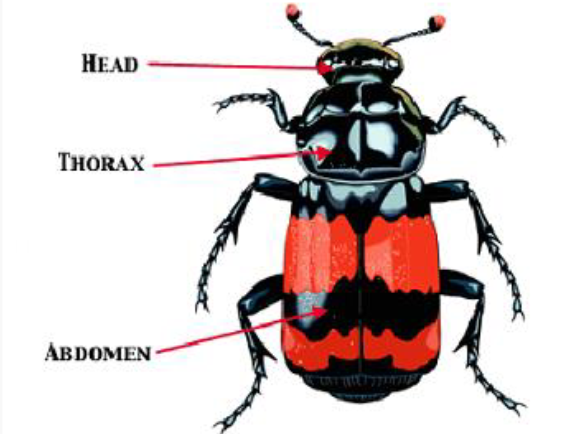
Class Insecta 3 major regions
1 PAIR antennae
2 PAIRS of wings
3 PAIRS of legs (6 legs total)
compound eyes
4 characteristics of class insecta
chewing
mouthparts of beetles, cockroaches
piercing, sucking
mouthparts of mosquitoes, bugs
lapping and sponging
mouthparts of flies
Prosoma (cephalothorax)
Opisthosoma (abdomen)
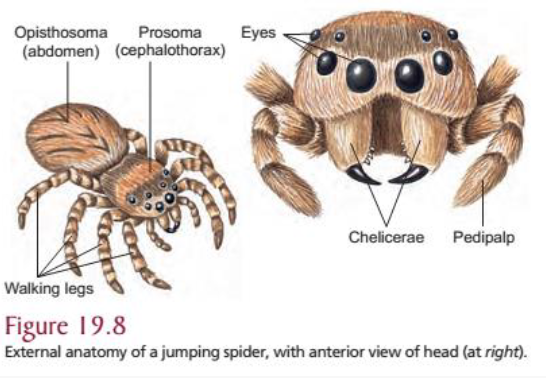
Class Arachnida (2) major regions
4 PAIRS of walking legs (adults) (8 total)
NO antennae
NO wings
Class Arachnida (3) characteristics
Order Scorpionida (scorpions)
Order Araneida (spiders)
Order Acarina (mites, ticks)
(3) Arachnid Orders Med Important
Order — arachnids
Order Scorpionida
Pincers on the 1st set of appendages (pedipalps)
Long tail with stinger
Four pairs of legs
pedipalps
appendages of class arachnids
Order Scorpionida
IMPT: sting humans
hemolytic venom causes a painful swelling at the site of the sting
neurotoxic venom may produce numbness at the sting site, profuse sweating, salivation and nausea.
Order Scorpionida
If the victim is alive for 3 hours after
the sting, survival is capable
Order Araneida
slender waist (pedicel)
chelicerae on 1st set of appendages = injects venom
Lactrodectus (black widow spider)
Loxosceles (brown widow spider)
(2) dangerous Araneida species
black widow
mature female is deep black
gagambang gubat
black widow spider
bite can cause light swelling and two tiny red spots may
appear, with local redness at the point of attack
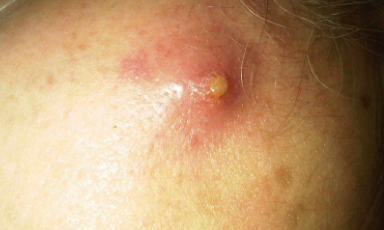
Loxosceles
genus of venomous spiders
Loxosceles
venom produces necrotic lesions in the tissues
venom is carried by the bloodstream causing red blood
cell destruction
Mites and Ticks
round or oval
dorsoventrally depressed forms
head, thorax, and abdomen fused together
no visible segments
Sarcoptes scabei (itch mite)
Whitish and disc shaped, flattened ventrally
with common name

peg-like protuberances, few bristles
Dorsally, the mite is covered with numerous small peg-like
_____ and a few ____
Sarcoptes scabei (itch mite)
Legs are short and stubby, divided into five ring-like segments
S. scabei
trasnfer via direct contact and to a limited extent from undergarments or soiled beddings
15-20 minutes
how much time for S. scabei to transmit person-person
11
The average number of adult female Sarcoptes found on a person is about
Scabies
caused by S. scabei
galis-aso
contagious
Note: Female mite favors places on the body where
the skin is wrinkled (wrists, elbows, feet, between fingers)
Ticks
parasitologically significant
vectors of diseases
transmitting pathogens like protozoa, bacteria, and viruses
Order copepoda (cyclops: freshwater crustacea)
Order decapoda (macrocrustaceans, crabs, lobsters, shrimps)
(2) Tick orders of Med IMPT in Class Crustacea
with examples
Order Copepoda (cyclops)
Body: cephalothorax and
abdomen
6 pairs appendages on head
5 pairs appendages on anterior thoracic trunk region
Copepods
Intermediate host for Dracunculus medinensis (Dracunculasis)
human parasite
Dracunculus medinensis
Infective: L3
MOI: drink unfiltered water
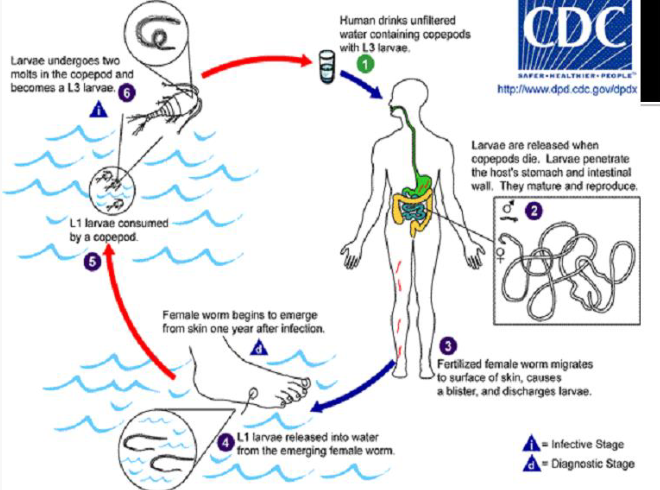
human parasite carried by copepods
with infective stage and MOI
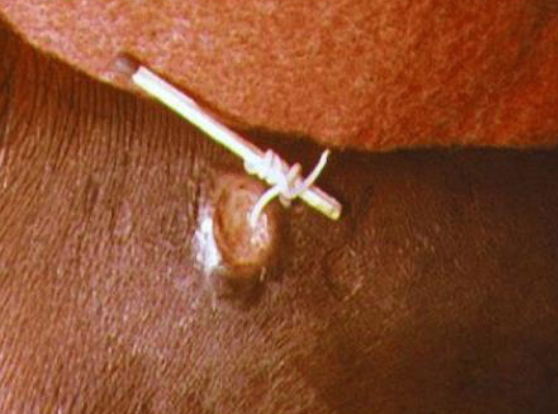
Class Diplopoda (millipedes)
2 pairs of legs per segment
Class diplopoda/millipedes
Most feed on decaying matter.
Some species can eject cyanide (poison)
millipedes
Secretions ooze from the small pores arranged
along its sides and produce dermatitis and severe
itchiness in humans
Millipedes
In chickens, it can cause permanent blindness.
rarely enter houses
Class Chilopoda (Centipedes)
1 pair of legs per segment
move rapidly, often under logs, some in homes
can bite
poison claws (modifiied 1st pair of legs)
Centipedes
have poison claws (modifiied 1st pair of legs)
Centipedes
most are harmless (since only few have fangs strong enough to penetrate the human skin
mostly bite in self-defense
amt of venom introduced depend on size
Class Insecta — Order Diptera
3 pairs of legs (Class — Order)
Class insecta — order diptera
they carry Mosquito-borne diseases:
a. Malaria
b. Filaria
c. Dengue
d. Japanese Encephalitis
Malaria
Filaria
Dengue
Japanese encephalitis
Mosquito-borne diseases (4)
Anopheline mosquitoes
Culicine mosquitoes
(2) important divisions or tribes of mosquito vectors:
Anopheline mosquitoes
tribe/division
consisting of Genus Anopheles, which are vectors of human malaria and human filariasis
Culicine mosquitoes
tribe/division
vectors of dengue, Japanese encephalitis and human filariasis, which includes the genera Aedes, Culex and Mansonia
Anopheline — Anopheles — malaria, human filariasis
Culicine — Aedes, Culex, Mansonia — Japanese encephalitis, human filariasis
Tribe — Genus — Disease
type of antennae
Class insecta — order diptera
Differentiation of sexes is based on
Male: plumose or bushy
Females: pinnose or less bushy
(2) types of antennae in class insecta — order diptera
Anopheles flavirostris
most important vector of
malaria in the Philippines
A. flavirostris
Wings usually dark or with one pale spot present
A. flavirostris
At rest, the body forms an angle nearly vertical with the surface (head, thorax, and abdomen are in a straight line
Mansonia bonneae
vector for brugian filariasis
Mansonia bonneae
ADULT: light to dark brown in
color light yellow to golden in
color
LEGS: pale markings
WINGS: white and dark broad
scales

lymphatic vessels
M. bonneae
The parasite reach the _____ where they develop
into adult worms
Aedes egypti (urban dengue)
Aedes albopictis (rural dengue)
(2) vectors of dengue in PH
Aedes egypti (urban dengue)
tiger mosquito
black or dense brown
White scales forming on the
thorax & legs
Tip of the abdomen is usually
pointed
Aedes albopictus (rural dengue)
adults are relatively small and show a black and white pattern due to the presence of white/silver scale patches against a black background on the legs and other parts of the body